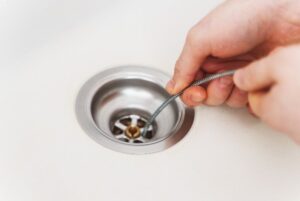If you have a clogged PVC pipe or want to prevent your pipes from clogging, it may be time to clean the inside of your pipes. Fortunately, with a plunger or snake and some dish soap or enzyme / bacterial drain cleaner, you can easily clean most PVC type piping on your own.
Why Clean the Inside of Your Piping?
People often clean and remove lettering on the outside of PVC, particularly if the pipe will be visible, but there are plenty of reasons to consider cleaning the inside of your PVC pipes. One of the most common reasons to clean the inside of PVC is to clear a clog. If you notice water backing up in your sinks, showers, toilets, and even washing machines, it’s likely caused by a clog.
Of course, starting your day with a shower full of water is never enjoyable. That’s why it’s often a good idea to clean your pipes regularly to prevent clogs from forming. The pipes leading from your kitchen sink, for example, could contain a buildup of grease over time. HVAC drain lines can commonly become clogged, as well. It’s much easier—and less stressful—to clean these pipes frequently than to clear a clog that is causing water to back up.
Cleaning Techniques
Plunger or Snake
If you have a clog or potential clog, it’s best to have both of these tools on hand. While people usually associate a plunger with toilets, it’s also incredibly effective at clearing clogs in sinks, as well as shower and bathtub drains. A snake can be helpful to dislodge clogs that occur further down the line. You can use these tools on their own or combine them with one of the other cleaning methods below for even more drain cleaning effectiveness.
Dish Soap Method
For simple clogs or regular cleanings, warm water and dish soap often does the trick. To use this method, heat a few gallons of water in a pot, then let it cool for about two minutes. Mix in a few drops of dish soap, then pour it down the drain.
Enzyme / Bacterial Drain Cleaner Method
There are many types of drain cleaners on the market. While chemical-based cleaners can be effective, they may also cause damage if not used properly. Enzyme / bacterial cleaners are safe to use and work well to clear organic material like grease and hair from drains. Be sure to follow the instructions on the bottle, and consider using a snake as well, to aid in removing the clog.
Potential Differences in Cleaning PVC vs Other Materials
PVC is designed to be very durable and resistant to rust and corrosion. It’s also nonporous, which allows for debris to be washed away easily, often without the need to remove or open up the pipes. Clogs in metal or copper pipes may be cleared in the same way, but sometimes, they need to be taken apart and scrubbed due to rust and corrosion that can be present.
Additional Tips
Pay Attention to the Cleaner’s Ingredients
While PVC is extremely durable, there are cleaners on the market that can cause damage. Ensure you read the labels clearly, including how to use or apply the cleaner. Also, don’t mix chemical cleaners. Typical use and makeup labels don’t include discussing outcomes from mixing multiple chemical types together. You could end up with a dangerous chemical reaction, damaging pipes, as well as your health.
Clean Your Pipes Regularly
While most piping systems are a last thought, it’s smart to consider regular maintenance to keep them flowing. If you notice slow flowing water, it may be an early sign of something building up. Stay on top of your systems with a regular schedule.
Pipe Disassembly May Not Be Needed
For regular cleaning and simple clogs, there’s typically no need to disassemble your pipes. If the clog is further down the drain, you can try using a plunger or a snake, in addition to a drain cleaner.
Know When to Call a Plumber
If you’ve tried to clear a blockage on your own and haven’t had luck, it may be time to consider calling a plumber. If not, you could potentially damage your piping and could even cause damage to surrounding fixtures. A plumber will likely be able to quickly and safely remove the clog without damage.
Whether you have a clog in your shower drain or you smell an unpleasant odor coming from your kitchen sink, cleaning the inside of your piping is often simple enough to do on your own.

